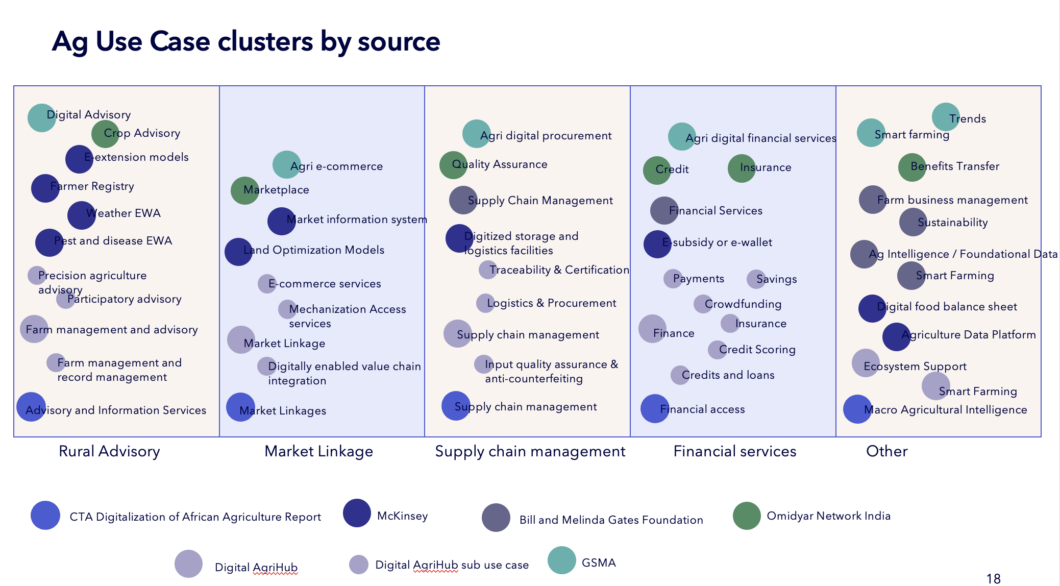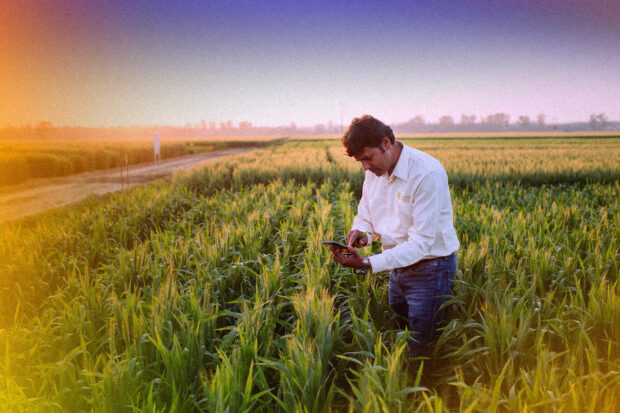One of the key promises of whole-of-government digital transformation is cost reduction where reusability of products across different government services can lead to optimization, minimized waste and duplication, and quicker benefits to citizens.
In practice, however, sectoral approaches to progress have been institutionalized over the past century to help policy makers analyze and forecast economic expansion and contraction in a period marked by unprecedented innovation and growth. This has led to an externality which has created siloes in data, communication, and decision-making and has led to inefficiencies. For national governments to embrace digitalization – with the shared optimization gains it promises – is a powerful, albeit ambitious task.
In 2022, with support from our partners at the Bill & Melinda Gates Foundation, DIAL embarked on a project to align the SDG Digital Investment Framework with the Agricultural Development sector, and to represent the AgDev taxonomies and products in the Catalog of Digital Solutions. The Catalog is a discoverability platform where users can find use cases, guidance tools, and software solutions for development challenges and it was created to support the whole-of-government approach to reduce duplication and fragmentation in the ecosystem.
Through our research, consultations, and synthesis, we have collected 5 key takeaways from the agricultural development sector that can help inform whole-of-government digital transformation.
Takeaway # 1: Root technology in local contexts
It can be appealing to focus on building software to solve specific technical problems and to quickly digitize citizen services rather than solving for high-level and slow-moving development goals. The former is attainable and incremental and provides much-needed short-term gains.
When technology considers local contexts, it can be adapted to meet the specific needs of a region or culture, and thus increase its chances of success. Involving local communities, experts, and stakeholders in design and implementation is an essential practice. For example, instead of building a messaging app to provide weather reports to rural populations, consider instead the programs and intermediaries (such as farmer cooperatives, government extension workers, and NGOs) that may already be providing key agricultural extension services and may have greater buy-in from smallholder farmers.
On the other hand, failing to consider local contexts can lead to a lack of adoption and acceptance of the technology, as well as a failure to fully realize its potential.
The gains from building software that meets functional needs will create more resilient technology for the long-term.
Takeaway # 2: Take advantage of commonalities
The functional layer can also be described as a “use case”, and this is a term that is widely understood – although differently – by technologists and non-technologists alike. In the SDG Digital Investment Framework, use cases represent a critical link between ambiguous, high-level SDG targets, to detailed business and technical components. We started with a theory that every sector has common, widely understood, and high-priority use cases.
Our research in agriculture reinforces this hypothesis, with an emerging pattern of common use cases in agricultural development. Represented below:

- Rural advisory – Rural advisory services enhance rural farmer productivity through local outreach and training services. These services help smallholder farmers adopt better practices by providing advisory services on the types of inputs they should consider, such as agronomic techniques (e.g., planting, harvesting, pest and disease management), post-harvest handling/processing and marketing advice (e.g., prices for key inputs and commodities), and overall farm business management tips (e.g., farming inputs, weather, market information).
- Market linkage– Market linkages, sometimes known as extension services for farmers, connect rural farmers to market information, products, and related services to improve rural incomes. By facilitating market connections, it fosters efficiency, transparency, accountability, and trust in agricultural value chains thereby improving the profitability to input-cost ratio, reducing risk, and improving yields and incomes.
- Supply chain management – In the agricultural scenario, supply chain is the management of inputs to the farm and outputs from farm to fork.
- Financial services for smallholder farmers – For farmers, e-banking services can connect them to high-quality and affordable financial products and services including payments, savings, credits and loans, credit scoring, and insurance. Due to the seasonal nature of their incomes, savings products allow farmers to manage their income across the growing cycle and not just during the harvest period.
- Ecosystem support (not mapped in the Catalog)–provisioning services for the ecosystem (such as water conservation, pollinator & wildlife support, carbon sequestration, etc.)
- Smart agriculture (not mapped in the Catalog) – the use of Internet of Things technology (such as in-situ sensors and drones) to improve farm management and yields.
Use cases can drive the reuse of existing tools and connect to leveraging common digital public infrastructure and they may have common key steps that can be reused across several use cases, reducing the need to replicate the development of this functionality. For example, registration of a citizen is required across rural advisory services, market linkages, supply chain management, and financial services for smallholder farmers. The digital building blocks required for registration include consent, registration, identity and authentication.
By building this functionality for one instance, it can easily be reused and customized for other agricultural use cases, and beyond in health, financial services, social services, etc., thus achieving the intended gains from whole-of-government approaches.
Takeaway # 3: Open Data and Datasets are important resources for technology deployments
Agriculture has a critical relationship with data that can be a key driver for positive development outcomes because of the co-dependency of the farmer and precise data for improved yield. As an example, farmers can provide real-time data about pest infestations to mitigate potential large-scale damages. On the other hand, national agencies are better suited to provide information on weather forecasts. This key relationship between farm-level and aggregate-level data can provide early warning insights for potential shocks that can have devastating impacts on the farmer livelihood, food security conditions, and the economy. Data can help mitigate this risk, and in turn, this can translate to gains in overall economic welfare.
Thus, access to open data plays an integral role in systemizing and accelerating technical innovation in agriculture, by streamlining agri-supply chains, supporting the monitoring of plant and livestock growth and health, and leveraging geospatial data for insights on rainfall patterns, water cycles, fertilizer requirements, and more. While data is critical for agriculture, it is not the only sector which can leverage open datasets. The UN Secretary General’s Data Strategy cites data action as a priority that can help unlock value on a wide range of issues including climate action, inclusion, human rights, peace and security, and governance and ethics, among other priority agendas.
Learn more about how the Catalog supports the discoverability of open data.
Takeaway # 4: We need to be able to compare commercial products and DPGs
The farmer-facing software solutions market is dominated – and saturated – by commercial players, limiting the potential for public or open initiatives. In addition, many of the commercial players bundle several use cases together to provide an end-to-end solution for farmers, that helps farmers track and finance their resource inputs, receive advisory and extension support, gain access to mainstream markets and distributors, and receive certifications.
However, there is great potential for open models and software to play a role in interoperability, integration & analytics, and data & content. In addition, there is a need for digital public infrastructure to advocate for and regulate data privacy and safeguards of rural populations, that are often providing a wealth of identifying data in return for these services.
To support this comparability, the Catalog now supports search and filter capability for finding commercial products and comparing with open source alternatives

Takeaway # 5: Consider the enabling environment
Finally, technologists and policy makers should consider the enabling environment when proposing technology solutions which is a tangential requirement for the success of digital transformation. Agriculture in particular, is susceptible to the devastating impacts of climate change. Smallholder farmers are at risk from major climate events, global warming, and human migration challenges. While we rush to digitize their livelihoods, let’s also consider baseline digital connectivity, favorable agricultural policies, a healthy business ecosystem, regional and global integration, a culture of innovation, and progress in non-digital infrastructure.
The Catalog’s year in review
Our team spent the better part of 2022 researching, developing, and adding data to the Catalog. In our last release, we added a brand-new product tour, introduced an evaluation rubric, and published a playbook on procurement.
We invite you to explore some of the changes and new features we have developed on the platform, read our quarterly release notes, and stay tuned for the many exciting things we have planned in 2023.
Get in touch with me by emailing info@solutions.dial.community
And don’t forget to sign up to be on our mailing list for our quarterly newsletter.





